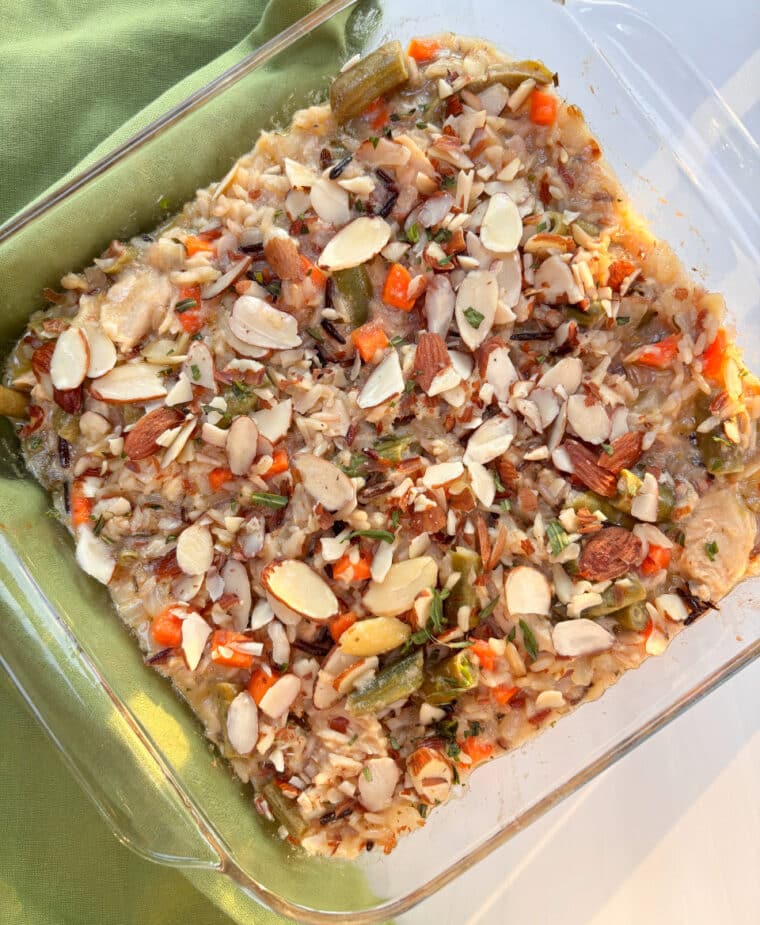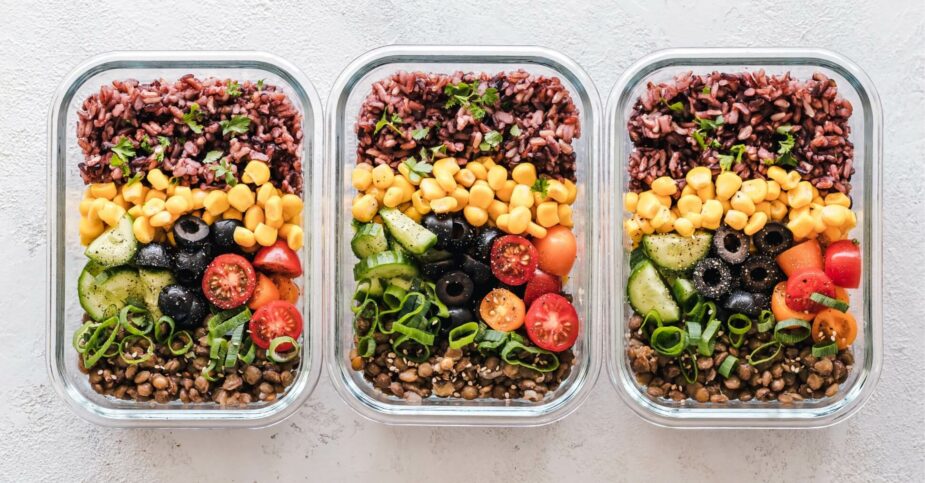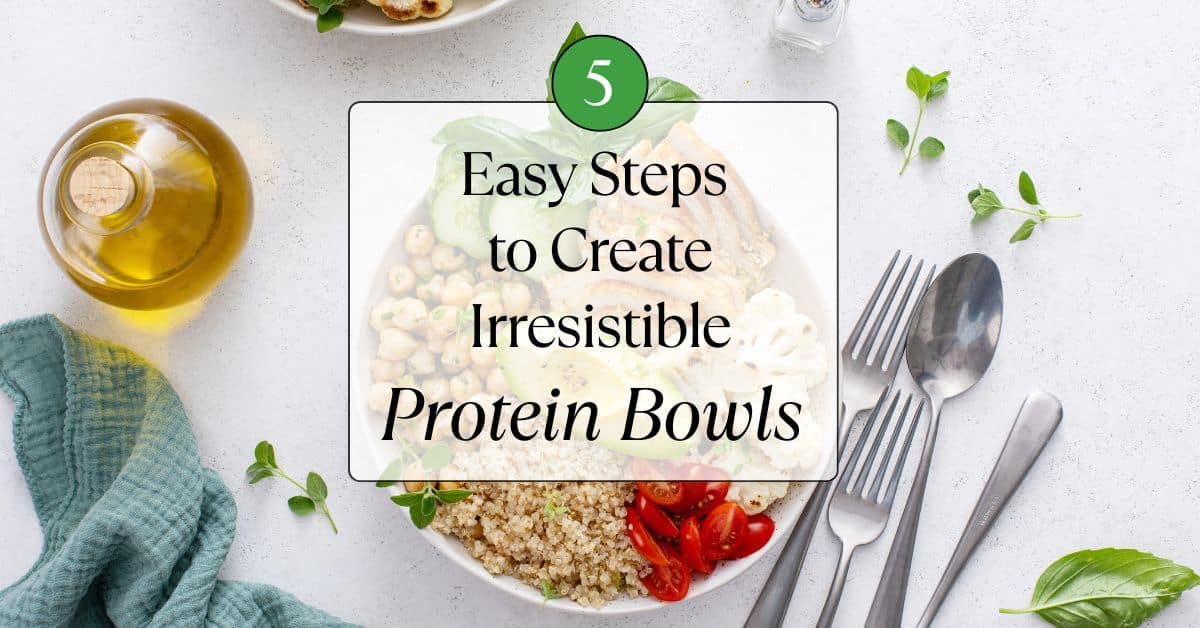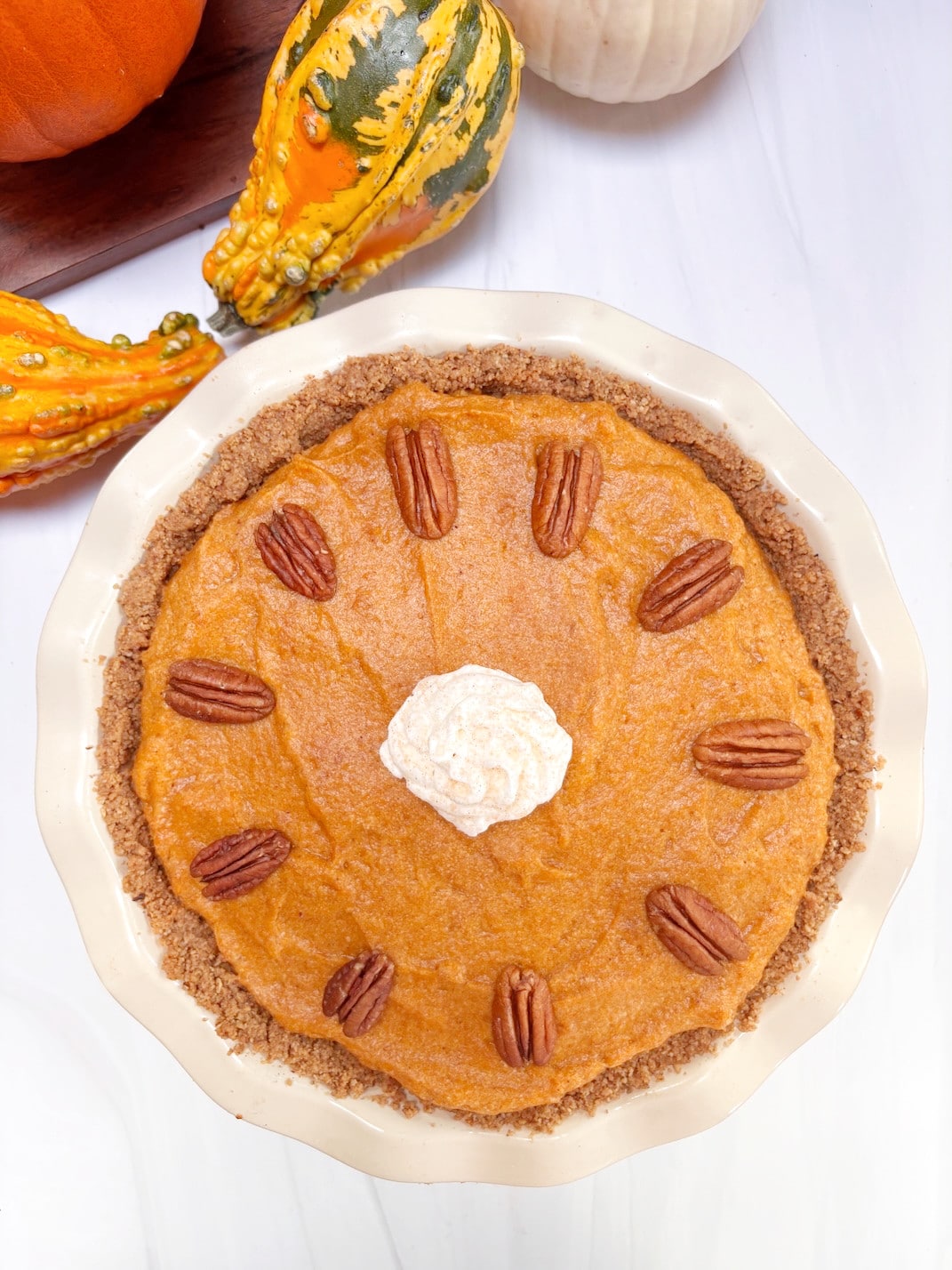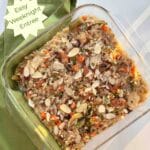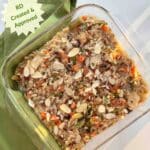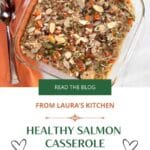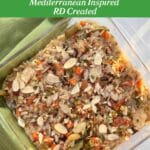There’s something so comforting about a casserole—especially one that’s hearty, nourishing, and easy to pull together with simple pantry and freezer staples. This healthy salmon casserole with brown and wild rice is all of that and more.
Made with a nutty brown and wild rice blend, protein-packed canned salmon, and colorful veggies like carrots and green beans, this wild rice casserole is a wholesome twist on a classic casserole.
The light, creamy sauce gets just enough richness from a touch of Gruyère cheese, while tarragon and black pepper bring fresh, bright flavor. Then topped with sliced almonds, it’s a dish that feels both cozy and elegant, perfect for busy weeknights or when you want something satisfying without a lot of fuss.
Ingredients To Make the Casserole
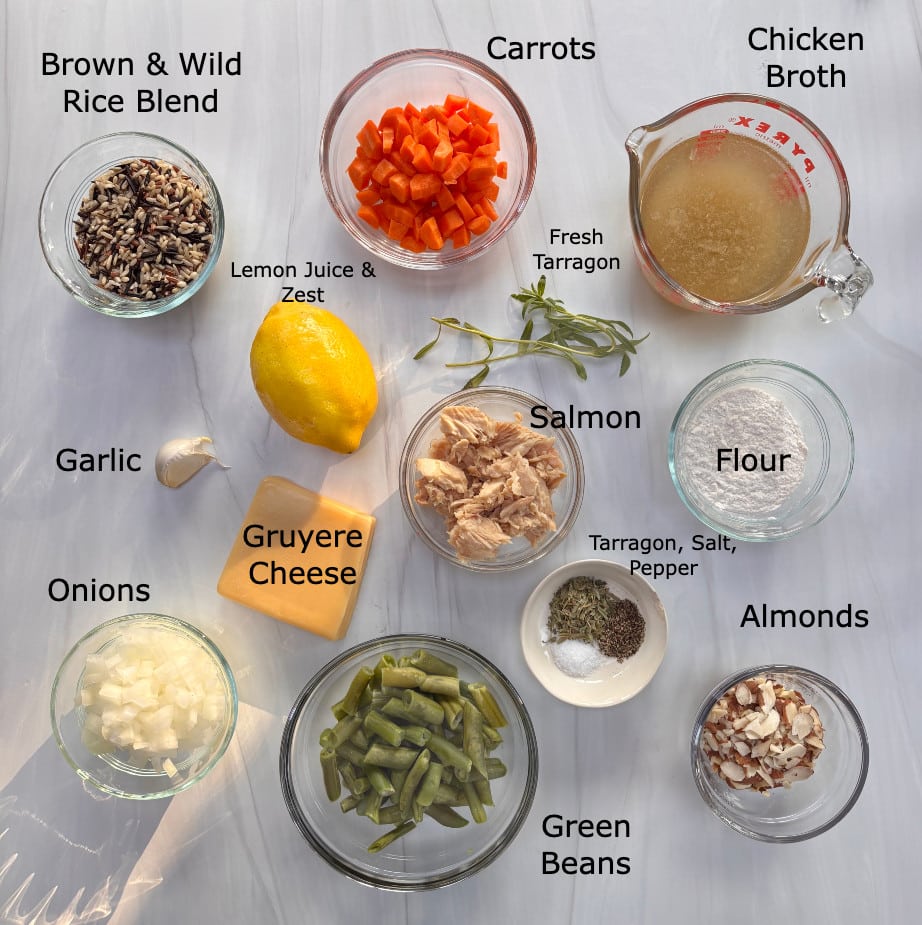
Brown and Wild Rice Blend
I use the Lundberg Wild Rice Blend, but any brown and wild rice blend will work. A half cup of cooked wild rice gives you 3 grams of fiber and 4 grams of protein. It’s hearty and has a nice nutty flavor. I also use this in my Rice Stuffing recipe.
Salmon
Canned salmon works perfectly in this recipe, or you could use leftover cooked salmon, too. Either way, this omega-3-rich seafood is a favorite of mine and is a great pantry staple.
Onions
A medium yellow onion or ½ a sweet onion, chopped, is part of the vegetable base.
Garlic
A clove of garlic, crushed and minced, gets mixed into the sauteeing onions.
Carrots
3 medium carrots, diced, finish off the sauteed veggies. The carrots add a little crunch and color, not to mention the brain-supporting anti-inflammatory antioxidants they contain.
Green Beans
Fresh or frozen green beans are delicious in this. I usually keep a bag of frozen green beans on hand, which makes this an easy pantry meal. But if you have fresh green beans, they would be excellent.
Olive Oil
I forgot to add olive oil to the picture above, but it is a critical ingredient, as you’ll use this to make the sauce. Most rouxs are made with butter, but to keep this more of a MIND diet-friendly meal, I used olive oil, and it worked well.
Olive oil is rich in heart and brain-healthy monounsaturated fats and is an integral part of the MIND diet, a diet that helps reduce the risk of Alzheimer’s disease. Plus, good quality olive oil has an earthy, grassy flavor, which makes a much more flavorful sauce.
Flour
All-purpose flour is used ot make the creamy sauce. You’ll combine it with the olive oil over heat and cook the starchiness out.
Chicken or Vegetable Broth
A light broth, either chicken or vegetable, is perfect for this dish. I prefer to use a reduced-sodium broth so that I can control the salt, but if you can only find regular broth, just cut back on the added salt below.
You’ll whisk the broth in with the flour and oil to make the sauce. You’ll end up with a very mild and slightly creamy sauce, but without using any heavy cream.
Lemon Juice and Lemon Zest
Lemon just adds a burst of freshness to this casserole, and lemon always works well with salmon. The lemon juice and lemon zest are both used. Don’t skip the zest. The zest is where so much of the lemon flavor is hidden.
Salt and Pepper
Both are used to help amplify and balance the flavors in this casserole, but you won’t need much of either.
Tarragon (Dried – Fresh, optional)
Dried tarragon gets added to the sauce with the salt and pepper. The dried herbs will bake into the casserole and flavor it throughout. You can sprinkle fresh tarragon on top just before serving if you have it.
Gruyere Cheese (or Swiss Cheese)
Gruyère cheese is a Swiss cheese that is similar to Swiss cheese that we are familiar with – the one with all the holes in it. But there are differences, and if you can find Gruyère, it is worth it.
According to Wisconsin Cheese, the main difference is that Gruyère cheese is aged for 5 months to over a year and has a rich, nutty flavor. Because it has such a rich flavor, you don’t need to use much of it to reap the flavorful benefits.
It is a perfect “melting” cheese, which also makes it a good choice for casseroles where you need a little extra creaminess.
Sliced Almonds
To keep this casserole on a lighter, healthier side, I decided to use sliced almonds as the topping, and I love the crunch they add. They add a delicious crunch and almond flavor that complements the lemon and salmon beautifully.
The other benefit? Almonds are also packed full of nutrients like calcium, fiber, protein, and antioxidants.
How to Make the Casserole
There are a few steps to the casserole, but it doesn’t take long to make. While the rice is cooking, get the rest of the ingredients cooked and ready to go.
Step 1 – Cook the Rice
Wild rice should be rinsed before you start cooking. This rinses off some of the starch and gives you a fluffier rice in the end. So don’t skip that step if the package recommends you do that.
Then cook your rice in either water, chicken, or vegetable broth. I like cooking it in broth for more flavor, but water is just fine.
Step 2 – Sauté the Vegetables
While the rice is cooking, saute the onions, garlic, and carrots. Cook them just until the onions are translucent. The carrots should still have a bite to them, and that is fine. They’ll continue cooking in the oven, and you don’t want mushy carrots! Remove these from the pan to a plate or bowl.
Step 3 – Make the Roux, or Sauce
Now make the sauce. This sounds much more complicated than it is. Start by heating olive oil in the saute pan. Once it is hot, whisk the flour into the oil and keep whisking for about 3 minutes. Adjust the heat down if it starts to brown. Heating the flour and oil like this helps cook the starchy flavor of the flour.
Then, slowly whisk in the broth and lemon juice and heat to a low boil while whisking. The sauce will start to thicken. Be careful to whisk out any lumps if they form. Then add the dried tarragon and shredded cheese and mix to melt the cheese.
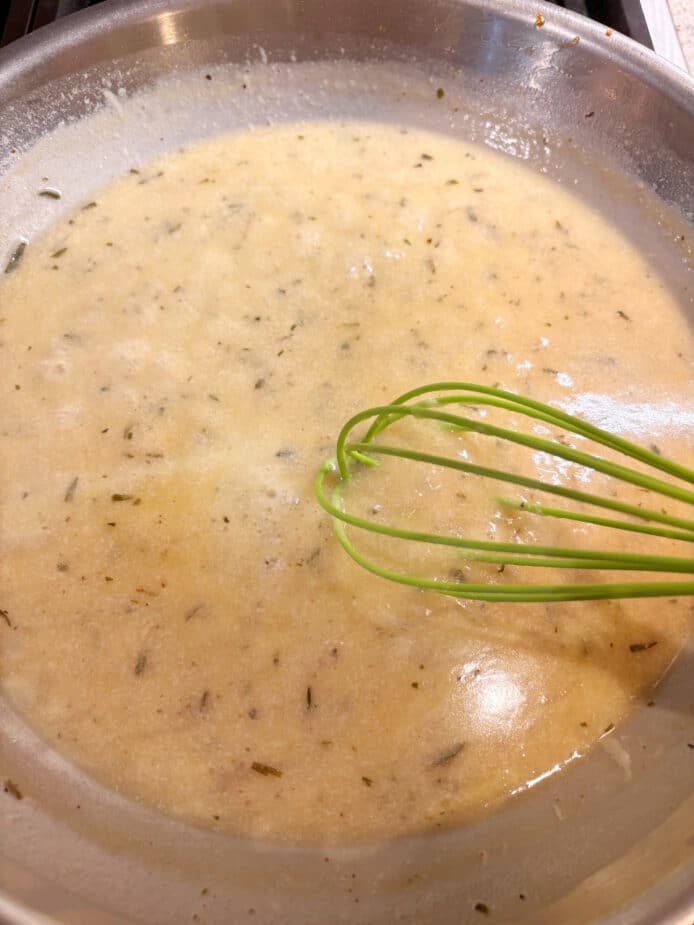
Step 4 – Combine the Ingredients
By now, the rice should be cooked. Add the rice to the sauce and mix in the cooked vegetables and the green beans. Gently stir in the salmon pieces. Try not to break them up too much.
Step 5 – Bake
Pour the rice, vegetable, and salmon mixture into the prepared casserole, cover, and bake. During the last 10 minutes, top with the almonds and continue baking.
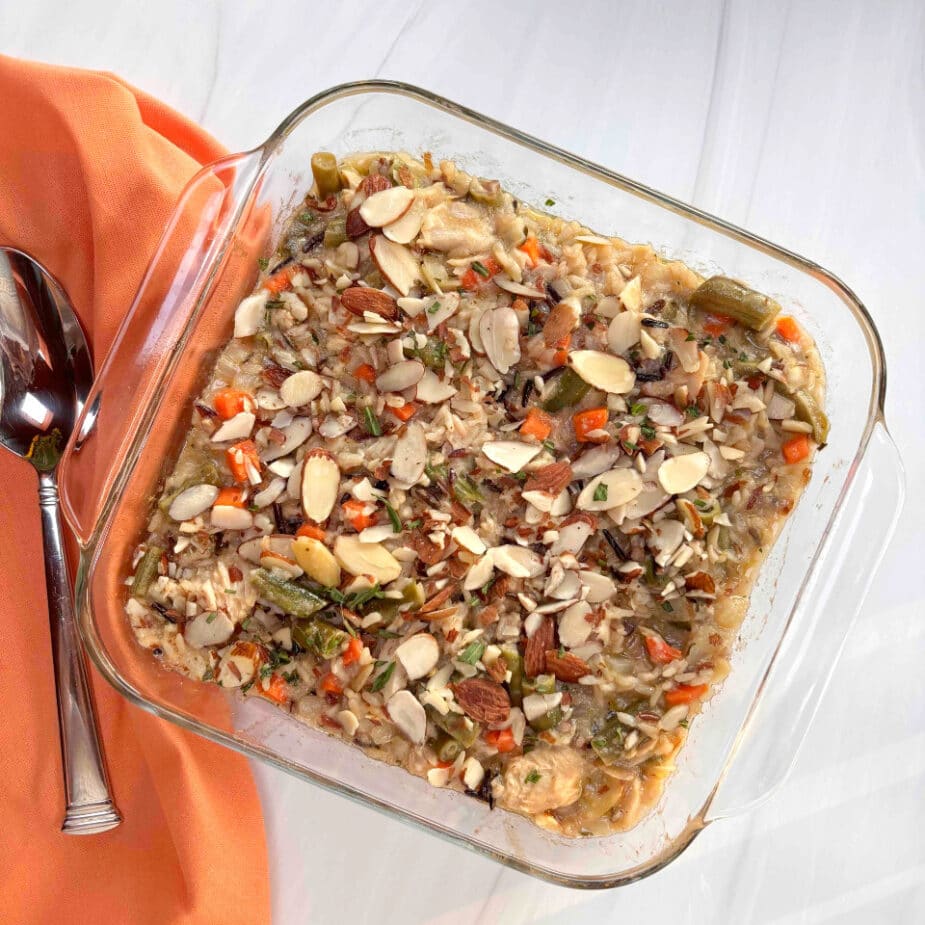
Frequently Asked Questions
Cauliflower rice is not a good replacement for wild rice in this recipe. In some recipes, cauliflower rice is a nice option to lower the carbohydrates. Cauliflower rice does have more moisture than rice, so your dish may be more watery than you like.
Tuna fish would be an excellent substitution in this recipe and is another pantry staple. You could also try cooked cod, crabmeat, or swordfish. You need a firm fish in this recipe.
Yes, bottled Alfredo sauce is a quick and convenient substitution for a homemade sauce. Just keep in mind it will add extra fat and saturated fat. Look for the lowest-fat option you can find.
Variations
- In place of salmon, try tuna or roasted chicken.
- Asparagus or broccoli would work in place of green beans.
- For an extra veggie boost, add some sliced mushrooms to the carrots and onions.
- In place of wild rice or a wild rice blend, brown rice or white rice would also work.
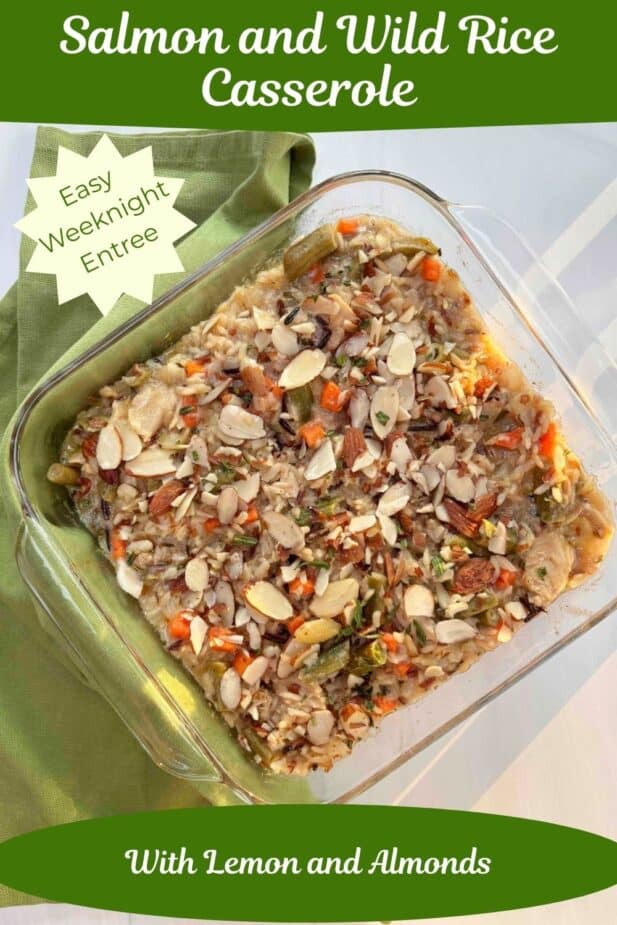
Storage Tips
Casseroles are perfect make-ahead meals, and they make great leftover meals too. This healthy salmon casserole is no different.
For a Make-Ahead Meal: Make the casserole through step 4 and place it in a casserole pan, ready for the oven. Cover it tightly and store it in the refrigerator for 2 – 3 days or the freezer for up to 3 months.
This casserole is best suited for an 8×8 pan. Disposable aluminum pans are ideal for meal prepping, as they can be easily pulled out of the freezer, thawed, and cooked. Double the recipe to make 2 – one for now and one for later.
If frozen, thaw it in the refrigerator overnight and then bake it at 350°F for 30 minutes, or until bubbling.
If you have leftovers: Store them in an airtight container in the refrigerator for 2 – 3 days or in the freezer for 3 months. Then reheat them in the oven or microwave. I prefer reheating in the oven, but a microwave will work.
- To reheat it in the oven, cover the pan with foil and bake for about 20 minutes, or until it is bubbling. Check the temperature with an instant-read thermometer, placed in the middle of the casserole. USDA recommends that casseroles be reheated to 165°F.
- To microwave the leftovers, place them in a microwave-safe dish and cover it with a microwave-safe covering. How long you’ll need to reheat it and on what setting depends on your microwave. Just make sure you stop it periodically and stir it every minute or so to heat it evenly. Also, check it with an instant-read thermometer to make sure it reaches 165 °F after being stirred.
This healthy salmon casserole makes four servings—just right for a small family dinner or for two people with leftovers to enjoy later (it freezes beautifully!). It’s an easy, balanced meal that proves pantry staples can be transformed into something truly special.
Warm up with this healthy salmon casserole made with brown and wild rice, canned salmon, and simple veggies. A light, flavorful dish that’s freezer-friendly and perfect for weeknights.
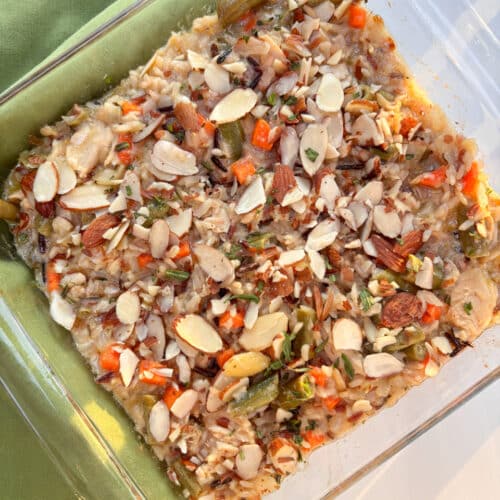
Salmon and Brown and Wild Rice Casserole
Equipment
- 1 Saute pan
- 1 8 x 8 casserole pan
- 1 sauce pan small
- 1 whisk
Ingredients
- 2 cups wild rice blend, cooked
- 1 tsp. olive oil
- 1/2 yellow onion, chopped
- 3 medium carrots, diced
- 1 garlic clove, minced
- 1/2 lemon, zested and juiced
- 1 cup chicken broth, reduced sodium
- 3 tbsp olive oil
- 2 tbsp flour
- 2 cans pink salmon, drained or 6 oz. fresh, cooked salmon
- 2 cups green beans cut in 2-inch pieces
- 1 oz shredded gruyere cheese (1bout 1/2 cup)
- ¼ tsp ground black pepper
- ¼ tsp. kosher salt optional
- 1 tsp. dried tarragon
- 1 tsp. fresh chopped tarragon
- ½ cup sliced almonds
Instructions
- Preheat the oven to 350℉. Spray an 8×8 casserole dish with cooking spray.
- Cook the rice in a small saucepan until just tender.
- While the rice is cooking, heat the olive oil in a large saute pan. Add the onions, garlic, and carrots, and cook for 3 – 5 minutes. Remove from the pan to a plate.
- Add the additional olive oil to the saute pan and heat over medium heat. Add the flour and whisk for 3 minutes. Slowly add the chicken broth and lemon juice, and keep whisking while bringing it to a low boil. Just until the sauce thickens. Stir in the dried tarragon, salt, pepper, and cheese.
- Add the lemon zest, vegetables, and rice to the sauce and gently stir to combine. Mix in the salmon pieces gently, being careful not to break them up too much.
- Pour the mixture into the prepared 8×8 pan, cover it with aluminum foil, and bake for 20 minutes. Remove the foil and sprinkle the almonds over top, and continue baking for an additional 10 minutes.
- Sprinkle with chopped fresh tarragon if desired before serving.

